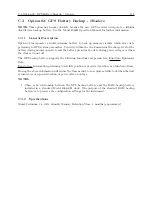
98
Startup and Basic Operation
10.4.5
Daylight Saving/Summer Time
The Daylight Saving / Summer Time (DST) configuration feature allows expanded settings. The
addition of AUTO allows the user to customize the DST/Summertime settings to match the re-
quirements of locations in either Northern or Southern latitudes. For setup information through
the front–panel interface, please see Section 6.3.1.
The DST/Summertime configuration can be changed through the serial port or through the front
panel keypad. For setup information through the RS-232C port, please see Section 9.2.4.
10.5
Position Display Modes
When the clock is first powered ON and acquiring satellites, the only position information available
is the previous position, stored in the clocks setup EEPROM. This position information reflects the
location of the receiver as determined by the last position while locked to at least four satellites.
Displayed position will be based on the most recent position fix.
Press the POSITION key to access longitude, latitude, and elevation data values. By repeatedly
pressing the POSITION key the display will continuously scroll through these values. If pressed
prior to acquisition of enough satellites to accurately determine and update position data, these
numbers will reflect the receiver’s power-on defaults.
Synchronization to a minimum of four satellites is necessary for precise determination of longitude,
latitude, and elevation. When meeting this minimum satellite lock requirement, POSITION values
will accurately correspond to the present antenna location.
10.5.1
Longitude Display
ANTENNA LONGITUDE
XXX
◦
XX’ XX.XXX” W*
Where:
*W = WEST, or E = EAST
10.5.2
Latitude Display
ANTENNA LATITUDE
XX
◦
XX’ XX.XXX” N*
Where:
*N = NORTH, or S = SOUTH
10.5.3
Elevation Display
ANTENNA ELEVATION
XXXXX.XX m WGS-84
Where the elevation is displayed referenced to the WGS-84 datum.
Summary of Contents for 1088A
Page 4: ...iv ...
Page 6: ...vi ...
Page 18: ...xviii LIST OF FIGURES ...
Page 23: ...1 4 Attaching Rack Mount Ears to 1088A B Series Clocks 3 Figure 1 2 Attaching Rack Mount Ears ...
Page 24: ...4 Unpacking the Clock ...
Page 32: ...12 Front and Rear Panels ...
Page 38: ...18 Connecting Inlet Power Input and Output Signals ...
Page 46: ...26 GPS Antenna and Cable Information ...
Page 48: ...28 Setting Internal Jumpers Figure 5 1 Model 1088B Main Board ...
Page 76: ...56 The Setup Menus ...
Page 112: ...92 Serial Communication and Command Set ...
Page 127: ...B 4 Physical Dimensions 107 Figure B 1 Suggested Mounting of the AS0094500 Surge Arrester ...
Page 128: ...108 Using Surge Arresters ...
Page 145: ...C 5 Option 04 Parallel BCD Output 125 Figure C 4 Option 04 Output Jumper Settings ...
Page 146: ...126 Options List Figure C 5 Option 04 Board Layout and Jumper Locations ...
Page 166: ...146 Options List Figure C 12 Option 17 Board Layout and Jumper Locations ...
Page 187: ...C 16 Option 20A Four Fiber Optic Outputs 167 Figure C 22 Option 20A Jumper Locations ...
Page 194: ...174 Options List Figure C 24 Option 23 Internal Jumper Setup ...
Page 196: ...176 Options List Figure C 25 Option 27 Jumper Locations ...
Page 214: ...194 Options List Figure C 28 Option 29 Connector Signal Locations ...
Page 270: ...250 Options List ...
















































